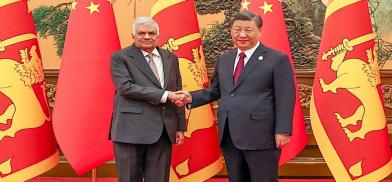Sri Lanka needs to optimise advantage from China's BRI 'grand strategy'
Given its strategic location blended with the old maritime silk route legacy, China places Sri Lanka in the pole position of its maritime strategy.

In the meeting between Sri Lankan President Ranil Wickremesinghe and Chinese leader Xi Jinping at the recent Belt and Road Summit in Beijing, Wickremesinghe stressed the importance of Sri Lanka as an active member state of the BRI in the success of Beijing's ambitious venture. Colombo’s position in the BRI throws a more nuanced light on China’s foreign policy objectives. The fact that China places Sri Lanka in a unique position in its foreign policy perspective relates to the island nation’s geopolitical significance for the ultimate triumph of the Belt and Road Initiative(BRI), which is often described as China’s “Grand Strategy”.
The concept of 'grand strategy' has been developed parallel to military strategy as a distinct principle aiming to foster other means beyond warfare in attaining a higher victory for a state. Celebrated military strategist Basil Liddle Hart traces the genesis of this concept to the modus operandi deployed by famous Athenian statesman Pericles at the advent of the Peloponnesian War in the 4th century BC. In contrast to a direct military strategy, which seeks to disrupt the military balance of the rival powers, a 'grand strategy' refers to the use of both military and non-military means to accomplish national interests in the long run. When Athens was outnumbered by the mighty infantry forces of the Spartan-led Peloponnesian league, Pericles opted for his 'grand strategy' to drain the enemy’s endurance.
Aim of Pax Sinica
China’s 'grand strategy' dates back to the inception of the People’s Republic of China in 1949 as its leaders focused on Chinese history, in particular the wisdom of Sun Tzu, who authored “The Art of War” in the 6th century BC. The meticulous analysis drawn by Sun Tzu epitomizes ultimate victory as winning over the enemy without waging war. The current Chinese strategic thinking seems to have been inspired by these military philosophies. From the beginning China’s key strategic objectives have rotated around three pillars consisting of preserving China’s national security, protecting national sovereignty, and maintaining international conditions for China’s economic development.
The BRI, which was launched in 2013 with great fanfare, is the cornerstone of President Xi Jinping’s foreign policy, which aims at the revival of Pax Sinica by 2050. History shows that there are two main paths to securing global hegemony. The first one is related to the use of military force aligned with the economic force, and the second one embodies the use of ideas in securing global hegemony in which military strength comes as a last resort. Both Pax Romana and Pax Britannica cemented their power on the pillars of the first path, whereas the American empire that emerged in the post-war era represents the ethos of the second path.
The question that comes to the fore is how China presents the Belt and Road Initiative as its grand strategy containing the features from the second path. If BRI’s two-pronged strategies are successfully carried out by around 2050, there is likely to be a future world order governed by China. Pax-Sinica will be different from the current global order, with all signs showing that China is revising the existing global order and initiating counterparts of its own. The 2050 Pax-Sinica, should it appear, will be dominated by China’s economic primacy and its version of an ideational value system seen as universal. It remains uncertain what the power of the “ideas” offered by China will be beyond 2050.
Would the Pax-Sinica world remain democratic or authoritarian? Would the world economic structure still be capitalist? Would China transform into a different polity, over the next three decades, and with it, itself, into a global leader?
An alternative vision
The answers to the questions are set to unfold by the course of the development of BRI. In a world where American liberalism still prevails as a governing philosophy with its special characteristics such as human rights, good governance, and the rule of law, the BRI 'strategy' lacks universal legitimacy. The famous slogan articulated by Xi Jinping is “building a community of a common destiny”. This narrative captivates many of its partner states as a broader version of globalization that fundamentally differs from Western-typed development. However, many critics in the West debunk Xi’s philosophy as nothing more than a geopolitical project intending to pressure poor countries into debt traps for the fulfillment of Beijing’s political and economic aims.
From such a point of view, BRI is nothing more than a neo-colonial project that hastens China’s ascendency to the global stage. To counter these polemics, China produced an alternative vision called “Global Civilizational Initiative”, presented last March as Beijing’s core blueprint for transforming the global order.
China knows fully well that its naval strength is of no match to that of the US yet, and Beijing will not provoke a direct military confrontation with the US on the sea. Instead, it will adopt a defensive posture. Given its strategic location blended with the old maritime silk route legacy, China places Sri Lanka in the pole position of its maritime strategy. It should be the primary concern of Sri Lankan policymakers to derive the optimum benefit of a strategic partnership with Beijing. The BRI seeks to elevate the position of China into a global influencer as the revival of “All Under Heaven” (tian-xia), which used to be the old vision of a "grand strategy" of imperial China.
(The author is a post-doctoral researcher affiliated with the Institute of Law, Politics and Development at Scuola Superiore Sant Anna, Pisa, Italy. Views are personal. He can be contacted at punsaraprint10@gmail.com )














Post a Comment